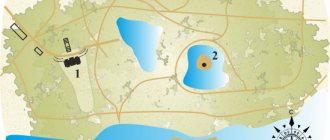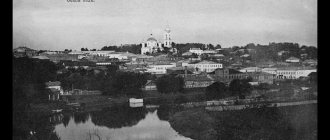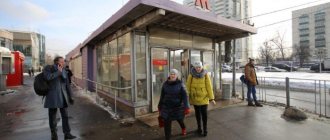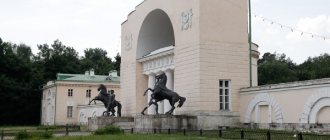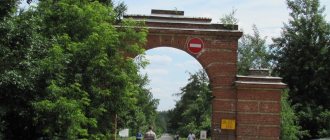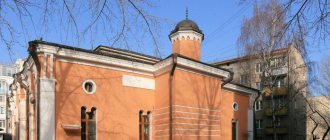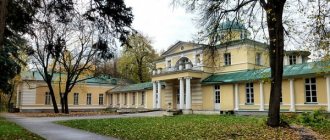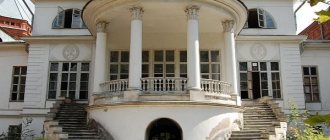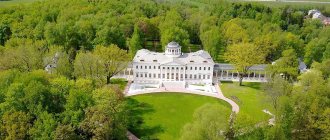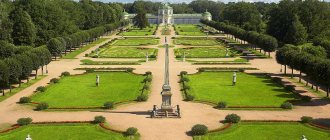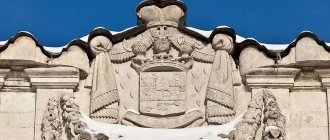Who would have thought that such a wonderful place would be just 15 minutes drive from my home. It's so strange, because I've been living here for several years. At the same time, I know so many beautiful places in Thailand, in the Krasnodar region, but my eyes did not notice what was nearby. I need to start looking at the world with my eyes wide open, in case I notice something interesting right under my nose.
It’s just a pity that this time we weren’t lucky with the weather, and that’s why the photos turned out a little gloomy.
Owners of the Sukhanovo Estate.
The most famous owner of Sukhanov was Prince Pyotr Mikhailovich Volkonsky, nephew of A.P.’s daughter. Melgunova. A participant in the Patriotic War of 1812, he received the rank of adjutant general at the age of 25. In 1815, Pyotr Mikhailovich headed the General Staff, and by the end of his life he had risen to the rank of field marshal general. Under Nicholas the First, Volkonsky served as Minister of the Court and Appanages. Despite his high position in society, Pyotr Mikhailovich was very thrifty. On the sidelines, Volkonsky was called “Prince No” and “Stone Prince” - because he often refused requests for help. His wife, Sofya Grigorievna, matched him.
Old photos
190s 1920s 1910-1914 1910-1914 1914 1925-1926 1950 1950-1952 1950-1955 1950-1955 1950-1955 1950-1955 1955-1965 1955-1963 1955-1965 1956 1962 1970-1975Sukhanovo Estate near Moscow.
However, for all his stinginess, the prince did not spare money on the improvement of his beloved estate near Moscow. Most of the Sukhanov buildings that have come down to us were erected precisely on the orders of Pyotr Mikhailovich Volkonsky. The main house was originally maintained in the traditions of classicism. Both facades were decorated with porticoes, and the main volume was connected to the wings flanking it through open colonnaded galleries. In 1843, the building was significantly rebuilt according to the plans of the court architect Konstantin Ton. The left wing and colonnade were demolished, and a new free-standing building appeared in their place. As a result of reconstruction, the right wing merged with the main house. The Tuscan portico on the main façade of the building was replaced by a rotunda with Ionic columns. In the forties of the 19th century, the interiors of the palace also underwent significant changes. The premises on the first floor were re-painted according to the sketches of the artist Fyodor Solntsev in “Egyptian”, “Turkish” and other exotic styles.
History of creation
The Sukhanovo estate in the near Moscow region dates back to the 18th century and is one of the traditional noble estates: an architectural ensemble in the spirit of Russian classicism, surrounded by a landscape park with gazebos and ponds.
"Sukhanovo" - park and estate of the Volkonskys in the Moscow region
Representatives of noble families lived here at different times, and Alexandra Fedorovna stayed here. Despite its proximity to Moscow and the abundance of leisure opportunities, this place is not very widely known.
The estate acquired modern features through the zeal of Princess Ekaterina Alekseevna Melgunova-Volkonskaya at the turn of the 18th–19th centuries. The owner of the estate, who had no offspring, transferred it into the possession of Prince Pyotr Mikhailovich Volkonsky, her husband’s nephew.
He enthusiastically set about improving the family estate and launched large-scale work in the estate park. The prince sent orders to prominent architects of the time, and with combined efforts, 1 main manor house, built in stone in 1770, was rebuilt.
A semi-rotunda with a cast-iron staircase appears, glazed floors above the galleries. The interiors are changing radically, in particular, Turkish and Egyptian guest rooms have been created, and the dining room has been decorated with porcelain candelabra donated by Nicholas I.
The library contained about 4 thousand luxuriously published volumes; in the entrance room the personal belongings of Catherine II were displayed, including ribbons of orders, night shoes and an embroidered dressing gown.
As a result of a fire in the 1920s, the house was destroyed and restored in Soviet times under the leadership of V.D. Kokorina. Now the renovated part of the building is occupied by the lyceum.
In 1993, the estate was transferred to the State Historical and Cultural Enterprise, which in a few years managed to turn the architectural monument into ruins. In 1996, the Union of Architects managed to return the estate, which was closed for reconstruction in 2002. Today there is a private educational institution here.
The Sukhanovo estate today.
The main house burned down in the late twenties of the 20th century. In 1935–1938, the external appearance of the building was restored, and the architects' holiday home was located in it. Currently, repair and restoration work is being carried out on the building again with the goal of turning it into a private lyceum. The architects have preserved only two wings of the estate. But the holiday home has now received a more “loud” name - the International Center of Architects.
Old maps
1797 1852 1878 1927 1928 1929 1931 1931 1941 1968 1987 2006 year 2009 2015Volkonsky family mausoleum in Sukhanovo.
The most interesting and beautiful building of the estate is the family mausoleum of the Volkonsky family, presumably built by Domenico Gilardi. In the center of the complex was the Temple of Demetrius of Rostov - a massive rotunda topped with a white stone “crown”. In front of the façade is a six-column portico of the Doric order. In Soviet times, two side galleries were added to the rotunda and a dining room was installed.
Sukhanovo. Estate near Moscow.
A few meters from the necropolis there is a copy of Sokolov’s statue “The Virgin with a Broken Jug”. The original was installed in Tsarskoye Selo. Once upon a time, the statue was installed near a spring, and water poured out from a broken jug. In the park on the shore of the pond, the “Temple of Venus” gazebo, erected in the first quarter of the 19th century, has been preserved. Once upon a time there was a statue of the goddess of love inside the gazebo, and the vault was painted with coffers. A frieze with images of a bow and arrow, as well as musical instruments - a lyre and a trumpet, has survived to this day.
The Sukhanovo estate is one of those once luxurious and glorious estates that are now in decline and neglect. Having replaced several prominent owners in its lifetime, Sukhanovo gained fame as the estate of the Volkonsky princes, who owned it for quite a long time and shaped the appearance of the estate in which it has partially survived to this day.
According to data provided on the creative portal “Pomodoro”
, the first mentions of Sukhanov date back to 1627, when the local territories belonged to Prince Alexei Mikhailovich Lvov. After the prince deigned to die, the possessions passed to his nephew, Semyon Petrovich Lvov, under whom the sovereign's cattle and horse yards, as well as a small settlement, appeared on the banks of the Gvozdnya River.
After Lvovy, Sukhanov was owned by Tikhon Nikitich Streshnev, a prominent statesman, to whom the village and its surroundings were granted by Peter I. Later, the estate was bought by A.G. Gurov, and even later - Alexander Petrovich Melgunov, under whom the “substantial” estate began to be formalized. After the death of Melgunov and his son Vladimir, it passed to Ekaterina Alekseevna Melgunova, who married Dmitry Petrovich Volkonsky.
So, having been in the hands of representatives of several prominent families, Sukhanovo ended up with the Volkonskys. In Soviet times, as in many other estates, various institutions huddled here, but now there is a lyceum and a holiday home for the Union of Architects.
The park at the estate is loved by local residents, and therefore the space in front of the gate is filled with cars.
Behind the gate something begins that I could not understand: to the right of the entrance there is an area of indistinct purpose fenced off, with cabins that reminded me of a plant nursery. A huge dog sitting on a chain behind the fence, at the sight of my worker-peasant soap box, began to bark loudly and rattle its chains - after which your humble servant, almost shitting his pants from unexpected fear, chose to put the camera in his bag and walk past. What is this, why is it? Unclear.
The fence ended in a picturesque ruin. It is believed that this building was once a stable.
If you go from the entrance along the most respectable alley, you can come to a colorful composition formed by the clergy’s house and two guest houses.
Symmetrical guest houses, of course, immediately fade into the background. As a person with a hint of culture, I understand that this is indecent, but as a stern man in the street, I forget about the indecency and run to look at the clergy’s house - yellow two-story buildings with an attic can be found in other places , and this is the first time I’ve seen such a either knightly or gothic house.
It was built around 1810-1820. According to rumors, the project was implemented based on a drawing by one of the Volkonsky children; However, the house has survived to this day with significant losses: the towers on the sides have not survived. And the rooster weathervane on one of the central turrets, which has come down to us only in a single copy, is about to make a suicidal flight from the spire.
By the way, pay attention to the battlements on the roof: in shape they resemble the battlements of the walls of the Moscow Kremlin. The Kremlin battlements, similar to the letter “M”, have already become a kind of calling card of the capital, but in fact the shape is not some special Moscow invention and is often found in the architecture of other European castles and fortresses.
Not far from the clergy house and guest houses there is another colorful ruin - the manager’s house.
Judging by the round turret, it was also built with imagination and, perhaps, also had a kind of castle “raid”.
In its current state, the house could become a movie star. Historical films, for example: a little work, and now - in front of us is no longer the manager’s house, but a building destroyed in battle. Or horror films - from some angles it looks so creepy, as if it had just materialized from a scene with some brutal murder.
From the manager’s house, as if we were in an epic or heroic tale, we can go left, right and straight.
Straight
I chose to go straight and, I suppose, I was right - a beautiful brick bridge opened up to my eyes, ideally laying on the slopes of the ravine.
From the bridge over the ravine there is a wonderful view of the Sukhanovsky pond and the dam (see, there is such a small bridge at the edge?), over which it crosses to once again become the Gvozdyanka river.
By the way, about the ravines. The landscape here is extremely cheerful in this regard! The estate buildings are located on a flat hill, but closer to the pond and river the level begins to drop steeply, in some places it even looks like a cliff.
Left
If, standing facing the bridge (or even being on the bridge itself), you go to the left, you can see another structure for which Sukhanovo is famous - the Volkonsky tomb.
In 1804, when Vladimir Melgunov died, Sukhanovo passed to his sister Ekaterina, who married Dmitry Volkonsky. In 1812, Volkonsky died from his wounds and was buried on his Ryazan estate, and Catherine, in memory of her husband, took care of the construction of a house church with a tomb. There is debate about who was the architect of the tomb, but it is believed that it was Domenico (Dementio) Gilardi.
Despite the depressing state of the structure, the majestic rotunda, the central part of the mausoleum, still looks impressive to this day.
The beginning of the Soviet period for the estate was marked by decline: during the years of the Revolution and the Civil War, individual buildings were destroyed and looted, and in the 1930s, after the estate was transferred to the Union of Architects of the USSR, noticeable changes affected the tomb. The existing building was rebuilt, a kitchen building was added to it and a dining room was organized.
The tomb actually ceased to be such, and the ashes of some of the Volkonskys were reburied nearby. Of course, I didn’t take a photo of the burial, just as I didn’t take a photo of the nearby statue “Virgin with a Jug” - a copy of the sculpture of P.P. located in Tsarskoye Selo Park. Sokolova. The sculpture also suffered: not only was it moved from the shore of the pond to the top of the hill, but some villains also took the jug; now there is a crack in its place.
Right
If you go right from the bridge, you can go to the main house of the estate. A wooden manor house appeared in Sukhanov back in 1766, before Alexey Melgunov bought the estate, but in 1770, already under Melgunov, construction began on a new one - stone and two-story. Later, by the will of his daughter, Ekaterina Volkonskaya, the main house was rebuilt. Since Ekaterina Alekseevna herself was childless, and her husband died in 1812, his nephew Pyotr Mikhailovich Volkonsky played an important role in the arrangement of the estate, who, being then the Minister of the Imperial Court and Appanages, was close to Emperor Alexander I and had the opportunity to attract work on the estate by the best craftsmen.
In 1917, there was a fire in the building; in early Soviet times, all sorts of outrages happened to it, as well as to the entire estate. And after the collapse of the Soviet Union, they also managed to do something weird; Now the building looks quite worn out, and if the “front” side somehow still retains its face...
...then the back one looks creepy. Part of the facade decoration has fallen off, part of it appears to have been restored, but not painted. I don’t know what exactly this is connected with, but now the building looks as if restoration was abandoned somewhere halfway through. In any case, it does not appear that any external work is being carried out now.
To the left of the main house of the estate (see panoramic photo above) there is a residential outbuilding, the so-called “Cat House”. The outbuilding received such a funny name because of the sculpture of a cat with an arched back installed in front of it; I wonder what era gave Sukhanov such a colorful note?
A park
The park at the estate looks quite dull in autumn colors, but it has a number of features that are relevant in all seasons.
For example, the landscape I mentioned earlier. In Sukhanovo, as in many other estates, they approached its use wisely: for example, the gazebo “Temple of Venus” stands almost on a cliff, and therefore it offers an extensive view of Sukhanovsky Pond, the village of Sukhanovo on its opposite bank and is presented as a prestigious Residential complex "Sukhanovo Park" (this obscenity was built quite recently).
An eight-column gazebo appeared on the territory of the estate under the Melgunovs. Previously, there was a statue of Venus, the goddess and patroness of love and spring, but it has not survived to this day.
Another interesting detail of the park is a cascade of ponds; the largest of them is clearly visible through the trees from a large part of the estate: the Volkonsky tomb and the rear facade of the main house are facing towards it, and the “Temple of Venus” gazebo rises above it.
There is a strange pier on the pond.
The other two ponds, included in the cascade and located higher, do not look so solemn. But next to one of them there is a spring.
Around the ponds and between the estate buildings, Sukhanovo has a network of alleys of varying degrees of amenities. Most of them look extremely harsh, and in gloomy autumn weather many of them have a somewhat eerie atmosphere.
There are even almost completely wild paths, which are stepped on from all sides by gnarled tree trunks and branches. It's like an enchanted forest!
The nature here cannot be called pristine, but it also adds a certain amount of enchantment to these semi-wild paths: in the far part of the estate there is an amazing silence, sometimes broken only by the cawing of crows, and on the ground every now and then there are various mossy stumps, which, as you know, are found in abundance in any enchanted forest.
It’s interesting that in Sukhanov I didn’t see any squirrels at all. When I visited the estates in Bratsevo
and
Tsaritsyno
, they rushed around in whole crowds, and I believed that in the Moscow region, where nature should, in theory, be more diverse, and the air at least a little, and cleaner, there should be even more of them. Maybe it’s no longer the season, or here they simply have the opportunity to distribute themselves more evenly across the territory - after all, in the above-mentioned estates located inside the Moscow Ring Road, they won’t be able to do this. In general, I haven’t seen any =/
Be that as it may, I really liked it in Sukhanov, despite the gloomy weather and the deplorable state of the estate ensemble. I hope that in the future its owners or the government will find funds for restoration - I wouldn’t want to lose such an interesting place.
Moreover, it is also significant in literary terms - have you noticed that the surname of the owners of the estate - Volkonsky - is strikingly similar to the surname of the princes from the novel "War and Peace" - Bolkonsky? The fact is that Leo Tolstoy was the grandson of Nikolai Sergeevich Volkonsky, who served as the prototype for the old prince Nikolai Andreevich Bolkonsky from the novel. And although the writer and Nikolai Volkonsky have the most indirect relation to Sukhanov - after all, they had Yasnaya Polyana! - their relationship with the owners of the estate is beyond doubt.
If you also want to visit the Sukhanovo estate, getting to it is very simple: from Paveletsky station (or any other station in the Paveletsky direction) you need to get to the Rastorguevo station, then walk - check the route on the map; You can drive by car from the M4 Don highway, from Vidnoye.
